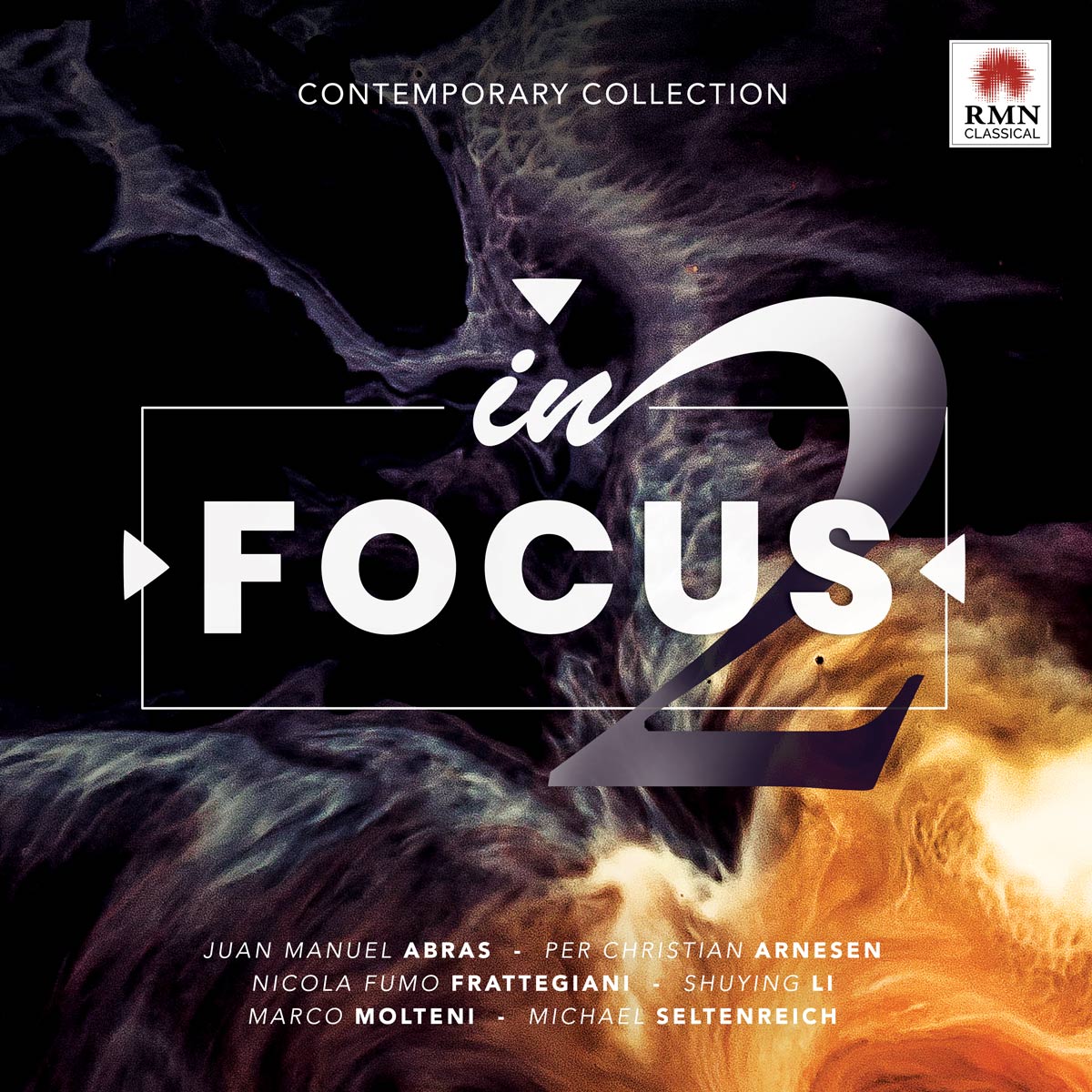MUSIC > In Focus 2

FULL ALBUM
Title: In focus 2
Release Date: 16 Jul 2020
Label: RMN Classical
Produced by R. Romano
Cover design by RMN Classical
Cover photo by Joel Filipe
Performed by
(in order of playlist)
01. The Mivos Quartet & The Jack Quartet
02. Emanuele Arciuli (piano) Emilie Cousin (voice)
03. Raffaella Palumbo (clarinets)
04. Erzhan Xu (bamboo flute), Noniko Hsu (concert flute)
05. Irati Sanz (violin), Itsaso Mungia (accordion)
06-07. Fernando Cruz (piano)
In Focus 2 by Various Artists
| N. | Play | Title | Composer | Time |
| 01 | Trajectories | Michael Seltenreich | 09:26 | |
| 02 | Barche Amorrate | Marco Molteni | 05:07 | |
| 03 | NOF4 | Nicola Fumo Frattegiani | 08:41 | |
| 04 | Weeping Bamboo | Shuying Li | 06:58 | |
| 05 | Astor in Astorga | Juan Manuel Abras | 03:59 | |
| 06 | Two Waltzes for piano: Waltze Friesé | Per Christian Arnesen | 03:30 | |
| 07 | Two Waltzes for piano: Il decimo friesé | Per Christian Arnesen | 02:29 |
Trajectories – A Study in Prosody is concerned with everything that we think of when we think of pitch. The main strategy the composer employs is having all of the different voices in constant flux, so they are in continuous transition (glissando) between pitches. This way we never hear a stable pitch that we might use as reference, and so there is no origin, nor a destination, but rather, a trajectory.
In the middle of the piece, for the first and only time we hear a long steady note, frozen in time by the entire ensemble. In the scenery of constant motion, the lack of movement becomes a quite intense anchor point.
In conversation with the composer, he revealed that the idea came to him while thinking about spoken language. He explained that he was fascinated by the incredible amount of information that is conveyed when people speak in form of the pitch contour of their voices, its stability, and its range; all while having nothing to do with the actual pitches themselves. It was this phenomenon that he sought to explore in Trajectories.
To realize his plan, the composer decided to use a string ensemble (in a joined effort by two of the finest string quartets in world). No ensemble is more apt for such a mission than a string ensemble, that can effortlessly glide between pitches with freedom, at various ranges, and at various speeds.
In the middle of the piece, for the first and only time we hear a long steady note, frozen in time by the entire ensemble. In the scenery of constant motion, the lack of movement becomes a quite intense anchor point.
In conversation with the composer, he revealed that the idea came to him while thinking about spoken language. He explained that he was fascinated by the incredible amount of information that is conveyed when people speak in form of the pitch contour of their voices, its stability, and its range; all while having nothing to do with the actual pitches themselves. It was this phenomenon that he sought to explore in Trajectories.
To realize his plan, the composer decided to use a string ensemble (in a joined effort by two of the finest string quartets in world). No ensemble is more apt for such a mission than a string ensemble, that can effortlessly glide between pitches with freedom, at various ranges, and at various speeds.
Barche Amorrate is a piece written for piano and female voice (mezzo soprano) on a text by the Italian symbolist Poet Dino Campana (1885-1932). The otiginal poem was included in the collection titled Canti Orfici published by the poet in 1914.
The text, thorough the reiteration of the words used, their sound, musicality and rhythm, evokes the movements of the sails that snap and whip in the wind, sometimes producing a fickle lament such as a wave breaking in the undertow. While the piano preparation echoes a sounds that refers to that of the Gamelan music of the Island of Bali.
The composer also adds: "...I think of the sails of the text as a symbol of men and women incessant life, often "whipped" by the inevitable "Waves" of destiny..."
The text, thorough the reiteration of the words used, their sound, musicality and rhythm, evokes the movements of the sails that snap and whip in the wind, sometimes producing a fickle lament such as a wave breaking in the undertow. While the piano preparation echoes a sounds that refers to that of the Gamelan music of the Island of Bali.
The composer also adds: "...I think of the sails of the text as a symbol of men and women incessant life, often "whipped" by the inevitable "Waves" of destiny..."
NOF4 tells the story of a brief moment in Oreste Fernando Nannetti’s life while sectioned in an asylum in the second half of the 20th century. During his 30-year hospitalisation, Nanetti created one of the "art brut" masterpieces “The book of life”, a graffiti engraved on the walls of the court’s ward where he was kept. NOF4 aims to provoke in the audience the view of a fragment of Nannetti’s daily work on the graffiti: him waking up, exiting the courtyard, beginning to work non-stop, and then him going back to his room. The structure of the composition is a dialogue between the electronic and acoustic sections. The latter formed exclusively by the manipulation of clarinets acoustic samples. The sound of the bass clarinet represents the community who inhabited those places, whereas the sound of the B-flat clarinet is Nannetti’s voice, the individual who, through his painstaking and methodical strength, is able to emancipate himself from reclusion, form his unwanted and not chosen human condition, determined by others.
Weeping Bamboo is written for flutes – eastern flutes including dizi, xiao (a vertical Chinese flute), xun (a globular, vessel flute), and western flute. The fixed media part is edited with various sounds and timbres recorded by the eastern flutes, to depict the hollow, weeping bamboo sound. The western flute performs with the accompaniment of the fixed media played in the background. Flute is a woodwind instrument ubiquitously rooted in every culture of the world. Despite the difference in materials and forms, flute's sound is well thought to be a delicate reflection of one's emotions and values. In the opening of the work all flutes play openly based on the same element. As the piece continues, more concurrent themes develop with greater harmony. Eventually, all instruments dance together and mingle into one voice.
Astor in Astorga, for violin and accordion, was composed by Juan Manuel Abras in 2017 and commissioned by the Aula de Acordeón del Conservatorio Superior de Música de Navarra to be premiered at the "Piazzolleando - Astor in memoriam" series, organized in that year by the mentioned institution to commemorate the 25th anniversary of the death of Astor Piazzolla.
The work incorporates music elements from Astor Piazzolla's Tango Nuevo and Andean pentatonicism, as well as the Spanish popular song "Leonesa, leonesa", which mentions the city of Astorga. These elements are organised into a harmonic frame based on Viennese serialism through a formal structure which conforms to the fugue. The work is elaborated by means of various contrapuntal procedures of Renaissance and Baroque origin, which are typically related to the fugue, in this case used from an essentially intertextual perspective. "Astor in Astorga" is dedicated to Nekane Iturrioz and was premiered on 18 May 2017 in Pamplona, at the Auditorio Guelbenzu - CSMN, by Irati Sanz (violin) and Itsaso Mungia (accordion).
The work incorporates music elements from Astor Piazzolla's Tango Nuevo and Andean pentatonicism, as well as the Spanish popular song "Leonesa, leonesa", which mentions the city of Astorga. These elements are organised into a harmonic frame based on Viennese serialism through a formal structure which conforms to the fugue. The work is elaborated by means of various contrapuntal procedures of Renaissance and Baroque origin, which are typically related to the fugue, in this case used from an essentially intertextual perspective. "Astor in Astorga" is dedicated to Nekane Iturrioz and was premiered on 18 May 2017 in Pamplona, at the Auditorio Guelbenzu - CSMN, by Irati Sanz (violin) and Itsaso Mungia (accordion).
The two waltzes Waltze Friesé and Il decimo friesé could be placed on the boundary between a certain Austrian tradition - of which they seem to pay an homage - and a more minimalist or pre-minimalist style or approach, which in some moment reminds of Erik Satie's works. They actually never fully step into either one or the other genre and in so doing seem to forma a bridge between the two styles.
The two works were recorded in a small studio room at the Department of Music, University of Stavanger, Norway, by Fernando Cruz, on a Yamaha Grand piano, August 29, 2017.
The two works were recorded in a small studio room at the Department of Music, University of Stavanger, Norway, by Fernando Cruz, on a Yamaha Grand piano, August 29, 2017.

